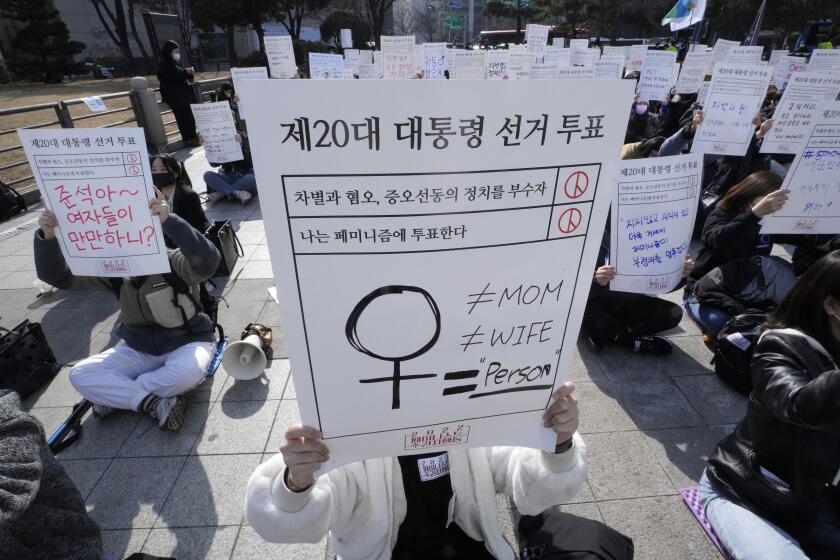Peru-Ecuador War Hurts Indians on Both Sides : Latin America: Indigenous people are being used as ‘cannon fodder’ and ‘human shields,’ advocates charge.
- Share via
QUITO, Ecuador — The two-week border conflict between Ecuador and Peru is uprooting native communities from their homeland, ravaging the fragile rain forest ecology they depend upon and drawing their men into the bloody fighting.
“This war has become a hell for all of these people who are located on the border,” said Luis Macas, president of the Confederation of Indigenous Nationalities of Ecuador.
Many Indians “are practically at the front,” Macas said in an interview Wednesday. “They are like cannon fodder on both sides.”
About 40,000 Shuar and 10,000 related Achuar natives live on the Ecuadorean side of the border and 12,000 Shuar-Achuars live on the Peruvian side, according to Macas. The border did not divide them before; they have always crossed it freely, hunting in the dense rain forest on both sides. Many on each side have relatives on the other.
“What the war has done is impose a confrontation, on the Ecuadorean side as well as the Peruvian side,” Macas said.
Many Shuar-Achuar Indians had already belonged to both armies, he said. Ecuador’s Iwia Battalion, which has been fighting in the conflict, is composed almost entirely of Shuar-Achuars.
Both armies have recruited Shuar-Achuar civilians to serve as guides and scouts, said Macas. “They take advantage of their knowledge of the forest, the knowledge they have of the zone.” Asked if the Indians cooperate under pressure or out of a feeling of national duty, he said, “Both.”
The Latin American Assn. for Human Rights in Quito said Wednesday that Peru’s army uses native civilians “to make trenches and paths in the forest as well as for human shields” in combat.
Juan Parra, secretary general of the human rights association, said that Peru sends out natives “as advanced patrols in minefields.” He said an unknown number of natives have been killed, but their bodies have remained scattered in the forest around a besieged Ecuadorean post called Tiwinza.
“The cadavers are left out there,” he said. “Neither side claims them and neither side brings them in. . . . We have confirmed this with the Indians themselves, whom we have worked with for years.” He said the association’s field office in northern Peru also corroborated the report.
In Peru, native leader Evaristo Nukuag said Indians who participate in the conflict on the Peruvian side are volunteers, and he denied that they are used as cannon fodder. But he said that Shuars on the Ecuadorean side--some enlisted men and others civilian volunteers--are fighting on the front line because “they know the area. The sad thing is that they are the first to die.”
Nukuag is president of the Peruvian council of Aguaruna and Huambisa people, who belong to the same language family as the Shuar-Achuar. “I lament that this conflict is making victims of our brothers on both sides,” he said.
No native death toll has been reported in the conflict in the rugged region about 200 miles southeast of Quito. Ecuador says 11 of its soldiers have been killed. Peru’s President Alberto Fujimori told reporters Wednesday that 29 Peruvian combatants have died, but his defense minister reportedly told a closed session of the Congress that 31 had been killed and 70 were missing.
As hostilities continued Wednesday in the disputed border area, mediated cease-fire negotiations between Peruvian and Ecuadorean diplomats resumed briefly in the Brazilian capital of Brasilia after a three-day break, but the talks were suspended again until today.
The Confederation of Indigenous Nationalities reported Wednesday that 8,400 Shuars have been forced to evacuate 21 villages in the border area. Most of them have moved into forest areas away from the conflict, while about 1,000 are being cared for in refuges by the Ecuadorean civil defense.
Indians in the refuges have suffered from food shortages, respiratory infections and other ailments, said Parra of the human rights association.
“The Indians are part of the ecology,” he said. “You take them away from where they live and they get sick.”
The Ecuadorean Shuar Federation has taken a strong position against Peru. Guillermo Tsensu, vice president of the federation, told reporters in Quito on Wednesday that the cause of the conflict is “the vile, treacherous and cowardly aggression” by Peru’s president.
Wearing a feathered headband at a news conference, Tsensu voiced the painful division of Shuars caused by the conflict. “I call on all my Peruvian brothers who are Shuar to understand,” he said. “We don’t want war among brothers, but we do declare war against Fujimori.”
Times special correspondent Adriana von Hagen in Lima, Peru, contributed to this report.
More to Read
Sign up for Essential California
The most important California stories and recommendations in your inbox every morning.
You may occasionally receive promotional content from the Los Angeles Times.












